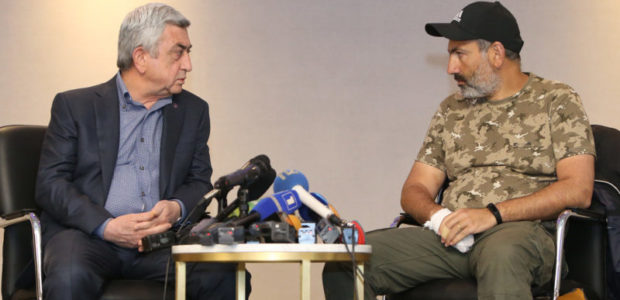
Armenian Events May Frighten Putin Even More Than Ukrainian Ones
Publication: Eurasia Daily Monitor Volume: 15 Issue: 62
By:

The popular mass protests that forced former Armenian president Serzh Sargsyan to resign as the newly installed prime minister of that country—a tactic he copied from Vladimir Putin (albeit with an added change to the constitution) to keep himself in power (see EDM, April 23)—may frighten the Kremlin leader even more than the previous Ukrainian Maidans. The events in Armenia show that its people want both the spirit as well as the letter of the country’s democratic procedures followed; the protesters railed against their elites’ attempts to use elections and constitutional reforms to solidify and sharply expand their rule. And most importantly, the Armenians who came out into the street to demand Sargsyan go were willing to act even as their country continues to face existential national security threats from its neighbors. This clash between democratic aspirations and the search for security is likely to define the future course of events in Armenia. The existence of both is, of course, at the forefront of Armenians’ minds right now. But additionally, the democracy-versus-security dichotomy in Armenia may offer possibilities for the frightened Kremlin to engage in dangerous mischief.
These points are made by Ukrainian commentator Vitaly Portnikov in one of the most thoughtful responses to the Armenian events to date (Graniru.org, April 24). Others have been more enthusiastic about the possibility that Russians will follow the Armenian lead (Ekho Moskvy 1, 2, April 23), while more sober assessments have pointed out that Russians are not Armenians—just as they earlier observed that Russians are not Ukrainians (Ekho Moskvy, April 24).
Russians are unlikely to go out into the streets any time soon or in equally massive numbers. And yet, what may be the most disconcerting aspect of the Armenian events, as far as President Putin is concerned, is the way those events actually unfolded, which appear to have particular relevance for him and his rule. As it happens, Sargsyan decided to leave office rather than fight not because hundreds of thousands of Armenians took part in public demonstrations, but because members of the Armenian military wholly went over to the opposition instead of defending him (Charter97, 1, 2, April 23). That was the death knell for the Armenian leader’s hopes to remain in power. Sargsyan implicitly acknowledged as much when he said, in his resignation announcement, that he had other options at his disposal but decided not to use them. Intriguingly, the potential role of the Armenian military in Armenian politics was something Russian commentators were talking about even before the quondam prime minister resigned (Kavkazoved.info, April 21; Regnum, April 23).
Because of the threat the Armenian model potentially represents to his own power, Putin is likely to move to stir up more conflict between Armenia and Azerbaijan. The dual aim will be to remind Armenians of their dependence on Russia for their security and to make them more willing to support a new authoritarian leader who will fit better into Putin’s vision of the proper form of rule in the post-Soviet space and more generally. That Sargsyan apparently did not ask Putin to intervene directly to support him is testimony to the Armenian leader’s awareness that the Russian ruler has the ability to cause problems but not to solve them. This represents a sharp contrast to the situation that existed with Leonid Brezhnev and the Soviet Bloc, exemplified by the “Brezhnev Doctrine” and armed intervention in Czechoslovakia during the 1968 Prague Spring. In contrast, the current situation more closely resembles the dynamics of Mikhail Gorbachev’s more focused involvement in the early period of the Karabakh conflict.
But Sargsyan’s failure to ask does not necessarily preclude Putin from ultimately intervening in the way he typically has across the post-Soviet space—by “hybrid” means. His most likely tactic will be to reignite the Armenian-Azerbaijani war to remind Armenians of their dependence on Moscow and to create in Armenia the sense of “a besieged fortress” that he has also promoted within Russia. Doing this effectively, however, may be more difficult for Putin than he knows.
Unfortunately for Putin but fortunately for the Armenians, his actions in this regard could have exactly the opposite effect he intends. On the one hand, the Kremlin leader could help promote a new national revolution among the Armenians, like occurred among Ukrainians since the 2013–2014 Maidan “Revolution of Dignity.” If similar trends were to take over in Armenia, Putin would inadvertently become the greatest nation builder in that Caucasus country’s history—just as he has become the greatest one in Ukraine. And on the other hand, if Azerbaijan and Turkey act with restraint and with a view to their long-term interests rather than fall into the trap of pursuing short-term goals, there is a chance—admittedly only a small one—that Russia could lose its hegemonic position in the Caucasus. But if that were to happen, a more stable peace might emerge in the region.
To expect such long-term restraint from either Azerbaijan or Turkey may, of course, be unrealistic, given that the authoritarian-leaning regimes in both undoubtedly also fear what Putin fears: popular risings that could threaten their power. Consequently, both Baku and Ankara may feel compelled to exacerbate the intra-regional conflict in order to mobilize their populations and redirect popular anger away from their regimes toward a foreign enemy—something Moscow will certainly try to exploit. In the current fragile situation, Western governments face the considerable challenge of ensuring this does not happen so that not only the Armenians but also the region’s other nations can live in democratic countries free of what has been pernicious Russian influence.



